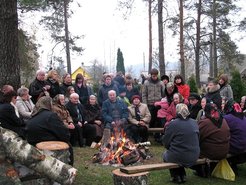Current Project
The church, the priest, the living and the dead are important transactors in a more or less homogenous rural Catholic environment in the southern part of Lithuania where I conducted ethnographic fieldwork between 2008 and 2009. One of the primary aims of my fieldwork has been to gather data on various exchange practices ‘around the church’. Questions addressed are, for example: Why do people (parishioners and (non)believers) donate to the church, the priest and the dead? What are the intentions, motivations and expectations of the different parties involved in such exchanges? Why and how do people make a distinction between donation, sacrifice, forms of paying and giving to the church, the priest and the dead? What are the main circulating items in these exchange processes, and what do the exchange practices reveal about the wider social and religious context they are situated in
At first, exchange practices might seem uni-directional: It was the laity to donate, pay, give to the church, the priest or the dead. However, depending on the motivations and intentions behind such giving, people identify various ‘returns’, and forms of capital accumulation. Furthermore, an analysis of the various material and immaterial items exchanged between these parties reveals wider social practices and structures, culturally significant patterns and relations.
In my analysis I use various approaches to exchange theory, especially those concerned with the notions of the gift and (in)alienability. Even though varying in a mode of exchange, the exchange practices carried out present a particular socio-religious picture of the two parishes I studied that turns out to be a useful framework to grasp key meanings and expressions of public and private of religiosity.

Traditional gathering in the cemetery for burning of old crosses and prayers for the dead.
